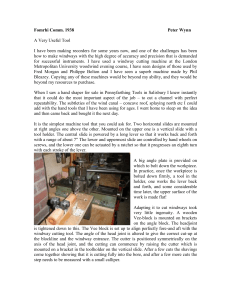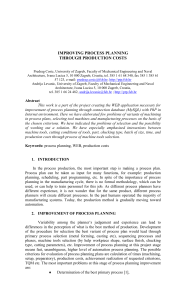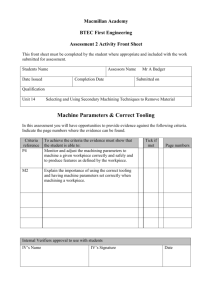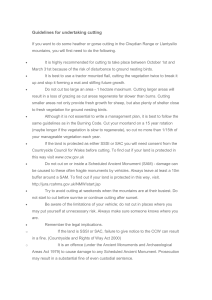《Manufacturing Engineering and Technology—Machining》Test
advertisement
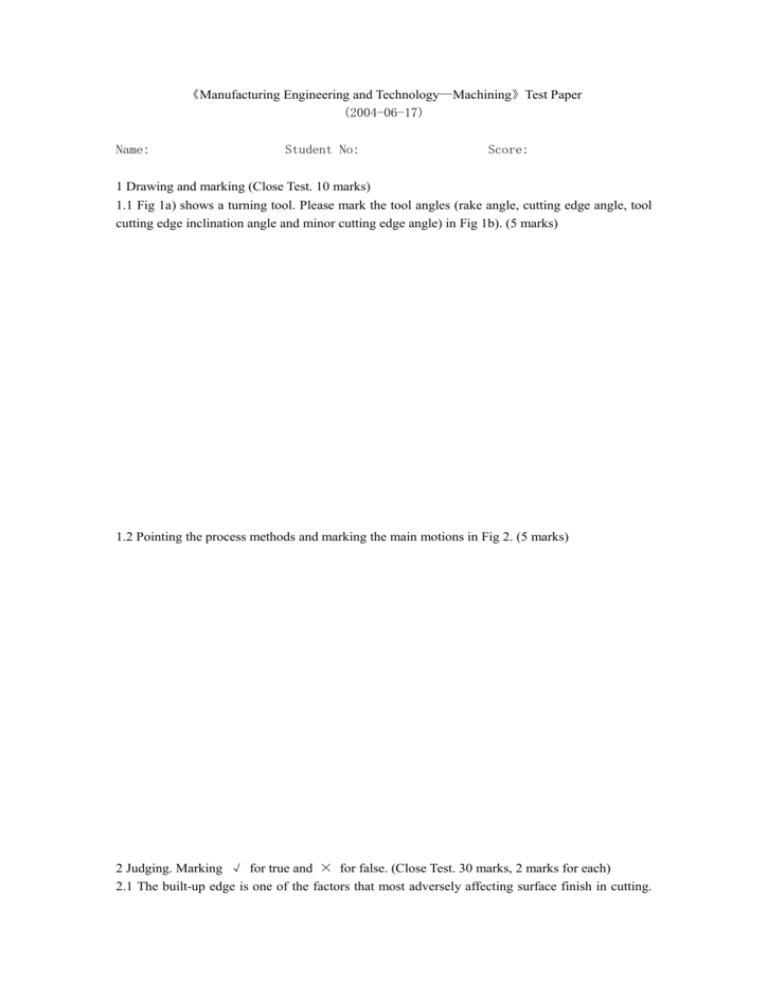
《Manufacturing Engineering and Technology—Machining》Test Paper (2004-06-17) Name: Student No: Score: 1 Drawing and marking (Close Test. 10 marks) 1.1 Fig 1a) shows a turning tool. Please mark the tool angles (rake angle, cutting edge angle, tool cutting edge inclination angle and minor cutting edge angle) in Fig 1b). (5 marks) 1.2 Pointing the process methods and marking the main motions in Fig 2. (5 marks) 2 Judging. Marking √ for true and × for false. (Close Test. 30 marks, 2 marks for each) 2.1 The built-up edge is one of the factors that most adversely affecting surface finish in cutting. (√) 2.2 When continuous chip are formed, the machine tool is easier to vibrate and chatter than the case in which discontinous chips are formed. (×) 2.3 In turning the highest temperature is usually found in the middle of crater wear area rather than the tool corner. (√) 2.4 When using carbide inserts to hard turning, we should cool the cutting zone with cutting fluid discontinously. (×) 2.5 In surface grinding we should use oils as grinding fluids and in thread grinding we should use water-based emulsions. (×) 2.6 Indexable carbide inserts are usually brazed to the tool shank. (×) 2.7 Diamond tools are usually used to finish-machining cast iron and steels. (×) 2.8 the most important limitation of high-speed steel is the cutting speeds that can be employed, which are low relative to those of carbide tools. (√) 2.9 In a planer, the workpiece is mounted on a table that travels along a straight path; in a shaper, the tool travels along a straight path, and the workpiece is stationary. (√) 2.10 Three-jaw chucks have jaws that can be moved and adjusted independently of each other; they can be used for square or odd-shaped workpieces. (×) 2.11 For drilling, reaming and tapping, blind holes must be drilled deeper than subsequent reaming or tapping operations that may be performed. (√) 2.12 In conventional milling (up milling), the feed direction is same as the cutting direction. (×) 2.13 The broaching operation can be used to machine internal and external surfaces, such as holes of circular, square, keyways, and flat surfaces. (√) 2.14 In gear hobing, the gear blank rotation is main cutting motion, while the hob rotation is feed motion. (×) 2.15 A hard grinding wheel means its abrasive particles have very high hardness. (×) 3 Qualitative problems (Close Test. 20 marks, 4 marks for each) 3.1 Why is it not always advisable to increase cutting speed in order to increase production rate? Answer: Because cutting temperature will be obviously raised with the increase of cutting speed, which has a great and adverse influence on tool life so that we have to resharpen or replace tool often. Then the production rate may not be increased finally and a poor machined surface is generated. 3.2 Which tool materials would be suitable for interrupted cutting operations? Why? Answer: The tool materials having good toughness such as HSS, whisker-reinforced nanocrystalline tool materials, would be suitable for interrupted cutting operation. Because in interrupted cutting the tool will suffer impact coming from workpiece, if the tool has no enough impact toughness it will break, generally, chipping will occur in its edges or nose. 3.3 Describe the conditions under which broaching would be the preferred method of machining. Answer: The conditions which broaching would be the preferred consideration include: a large numbers of workpiece will be broached; there are high requirements on dimension accuracy and machined surface finish for the workpiece; the the workpiece has a suitable structure so that it can be clamped securely in broaching machine, and it should have sufficient strength and stiffness to withstand cutting forces during broaching. 3.4 Why is the stiffness of machine tool important in machining operations? Answer: Because low stiffness of machine tool will result in larger magnitudes of vibration and chatter in cutting tools and machines, and can have adverse effects on product quality. The possible troubles include poor machined surface finish, loss of dimension accuracy of the workpiece, premature wear, chipping and failure of the cutting tool, damage to the machine components and objectionable noise, etc. 3.5 It is generally recommended that, when grinding hardened steels, the grinding wheel should be of a relatively soft grade. Explain the reason. Answer: The grade of a grinding wheel is a measure of the bond’s strength. A softer wheel has a weaker bond and /or a less amount of bonding material. It is recommended for harder workpiece such as hardened steel, because the dull grains are easily dislodged and other sharp grains can contact the workpiece to remove chips continually, so as to reduce residual stresses and thermal damage to the workpiece. 4 Synthesis and design (Open Test. 30 marks, 15 marks for each) Observing Fig 3. The a) and b) show two cutting tools, and the c) and d) show two parts. Choose one from a), b) and one from c),d) to do your design. 1) Which kind is the cutting tool? What operation can be done with the cutting tool? According with the tool materials and geometries, analyze the applied performance of the tool. 2) The part c) is made from normal medium carbon steel, 5 pieces are required; the part d) is made from wrought aluminum, 10,000 are required. Please choose suitable process methods to machine the part, and arrange the process routing for it. a) b) c) d) Fig. 3 1) a) It is a turning tool (left offset tool). The tool shank is made from medium carbon steel and there is a rhombic carbide insert clamped on the shank by a clamp screw. The insert is indexable and has four cutting edges, when one of its edge becomes dull, another sharp edge can be indexed to use. The tool has a positive working rake angle and clearance angle, and a sharp corner, it can be used for external cylindrical or taper surface turning or facing. The tool has a 90°cutting edge angle, so it can be used to turn 90°stage surface. The tool is suitable to cutting cast irons or steels at higher cutting speeds and larger back engagements of the cutting edges, but had better to avoid cutting discontinuously; it is suitable for dry cutting or turning with cutting fluids, but should avoid cooling discontinuously. Because carbide insert is hard and brittle, special attention should be given to proper mounting and using the tool in order to prevent from impact and vibrating as well heat stress. b) It is an end milling cutter and made from HSS. It has a solid structure and flat end, four helical cutting edges. It can be holden by a collet or special chuck, cut workpiece with its circumferential cutting edges. It can be used to mill plane, side surface and curved surface as well slot, but is not suitable to feed in axial direction. It is suitable to cutting nonferrous alloys, also ferrous alloys such as cast irons and mild or medium carbon steels. Because its hot hardness is low relatively, it is suitable to cut at lower cutting speeds and needs cooling continuously. However, it possesses good impact toughness, so, it can be used to cut discontinuously. 2) c) The part has a stepped cylindrical shape, so it can be produced by turning. Only 5 pieces are needed, we can choose an energy lathe to make it with P-type carbide insert or a HSS solid tool, and choose a rolled stock as the blank. Because the part has a severe shape and position tolerance, so the left end face and cylindrical surface should be completed in one setup of the part. The through hole has a higher finish requirement, after drilling a finish turning is needed. In addition, screw threading and chamfer are needed. Machining routing: Sawing the blank (longer than 5 times of the part)——holding the blank with a three chuck in lathe, let the overhang be little longer than the final length of the part——facing one end — — rough-turning external surfaces — — medium finish-turning the Ф 50 external cylindrical surface to the dimension for threading M50——finish turning the Ф44 segment to dimension accuracy and the step face with a left offset tool——coring——drilling the through hole——internal turning the hole——chamfering——grooving in theФ50 external surface—— screw threading——parting——turning around the workpiece and chamfering another end. d) The part is made from wrought aluminum alloy, a quantity of 10,000 pieces and a roughness of Ra 1.6 is required, so some economic processes such as extrusion should be used to produce the blank and a semi-finish-machining, finish-machining process should be applied. The through hole should be per-formed in the blank, then, the final dimension including the keyway may be broached optimally. There is no finish requirement for its external cylindrical surface and side surfaces, so these surfaces do not need to be machined. The three end faces marked Ra3.2 can be are produced with end milling cuter (the left end face and right cylindrical end face also can be produced with face milling). In order to obtain a high machining efficiency, a special fixture should be designed for fixing the workpiece on milling machine. Machining routing: fixing the workpiece on a vertical milling machine, milling the left end face— —turning around the workpiece, milling the right plane and cylindrical end face——mounting the workpiece on a broaching machine, broaching the through hole and the keyway. 5 Comprehension and discussion (10 marks) As you can appreciate, the cost of machining centers is considerably higher than more traditional machine tools. In view of the fact that many operations performed by these centers can also be done on conventional machines, how would you go about justifying the high cost of these centers? Do you think under what condition we should purchase a precise and expensive machining center, and when we should use an economic machining center, even traditional machine tools only? Answer outline: Machinine efficiency Machining accuracy and roughness Automation Multiple functions Machining time, labor, workshop area

